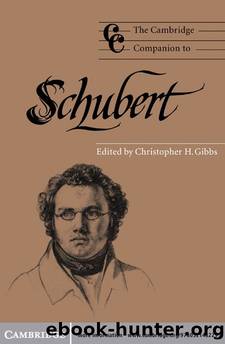The Cambridge Companion to Schubert (Cambridge Companions to Music) by Unknown

Author:Unknown
Format: epub
ISBN: 9780521482295
Publisher: Cambridge University Press
Published: 1997-04-17T00:00:00+00:00
D Minor String Quartet (D810), third movement, mm. 1â22
Schubert wrote the last, and in many ways the most original, of his string quartets, the G Major, in 1826. By this time he is no longer particularly concerned with writing variations, nor does he use short motifs cyclically to relate movements. Instead there is a complex web of connections, some obvious, others less so. The most important of these is modal contrast, the alternation of major and minor on several levels. The first movement begins with a juxtaposition of the tonic (G major) triad with its parallel triad (G minor), an idea he almost immediately repeats on the dominant (mm. 6â10). During the recapitulation (mm. 278ff.) he reverses the procedure; now the minor triad is first. In the quartetâs finale, a quick and extended sonata-rondo in 6/8 meter much like that of the D Minor Quartet, each time the refrain occurs there is a descending tonic minor triad followed by an ascending G major scale. Both the rondo slow movement and the highly imaginative Scherzo, a kind of miniature sonata form, also make important use of modal contrast.
Schubertâs String Quintet in C Major, for string quartet and a second cello (D956, summer or early fall 1828), is generally recognized as one of the finest chamber works of the nineteenth century, a fitting successor to Mozartâs string quintets. One reason for Schubertâs choice of two cellos may have been modesty, to avoid a direct comparison with Mozart who preferred two violas in his quintets. Another, probably stronger, reason was the richer sonorities offered by the cellos.
Spaciousness, a quality also present in the first movement of the G Major Quartet, characterizes the Quintet. The tone is set by the slow moving, even static harmonic progression with which the first movement opens. Unlike Schubertâs normal inclination to initiate a movement with a march-like or even dance-like rhythm, both here and in the opening of the G Major Quartet he presents his harmonies â rather than a memorable, well-contoured melody â without a regular rhythmic pulse. As a result, the Quintet opening contrasts powerfully with the surging rhythmic momentum generated during the continuation of the principal subject. In Beethovenâs conversation books Schubert is reported to have assiduously attended the first performances of all the older masterâs late quartets (SDB 536). One of the lessons he seems to have learned was the effectiveness of powerful, sometimes unexpected, contrasts. His own contributions in the Quintet are the rich sonorities, the way he balances the five instruments in varied groups, and the incredible beauty of the modulating middle theme. Particularly noteworthy is the way Schubert constructs the development section in the first movement. He devises an extended sequence consisting of three long, highly modulatory stages, a compositional technique he developed near the end of his career. 22 Shortly before the recapitulation (mm. 262ff.), Schubert introduces an ascending arpeggio in the first violin reminiscent of the principal theme in the first movement of Mozartâs C Major Quintet.
The sublime slow movement, one of Schubertâs relatively few Adagios, is in three parts.
Download
This site does not store any files on its server. We only index and link to content provided by other sites. Please contact the content providers to delete copyright contents if any and email us, we'll remove relevant links or contents immediately.
What's Done in Darkness by Kayla Perrin(26605)
The Fifty Shades Trilogy & Grey by E L James(19087)
Shot Through the Heart: DI Grace Fisher 2 by Isabelle Grey(19073)
Shot Through the Heart by Mercy Celeste(18944)
Wolf & Parchment: New Theory Spice & Wolf, Vol. 10 by Isuna Hasekura and Jyuu Ayakura(17125)
Python GUI Applications using PyQt5 : The hands-on guide to build apps with Python by Verdugo Leire(17006)
Peren F. Statistics for Business and Economics...Essential Formulas 3ed 2025 by Unknown(16886)
Wolf & Parchment: New Theory Spice & Wolf, Vol. 03 by Isuna Hasekura and Jyuu Ayakura & Jyuu Ayakura(16835)
Wolf & Parchment: New Theory Spice & Wolf, Vol. 01 by Isuna Hasekura and Jyuu Ayakura & Jyuu Ayakura(16459)
The Subtle Art of Not Giving a F*ck by Mark Manson(14364)
The 3rd Cycle of the Betrayed Series Collection: Extremely Controversial Historical Thrillers (Betrayed Series Boxed set) by McCray Carolyn(14151)
Stepbrother Stories 2 - 21 Taboo Story Collection (Brother Sister Stepbrother Stepsister Taboo Pseudo Incest Family Virgin Creampie Pregnant Forced Pregnancy Breeding) by Roxi Harding(13656)
Scorched Earth by Nick Kyme(12779)
Drei Generationen auf dem Jakobsweg by Stein Pia(10972)
Suna by Ziefle Pia(10895)
Scythe by Neal Shusterman(10353)
The Ultimate Python Exercise Book: 700 Practical Exercises for Beginners with Quiz Questions by Copy(9882)
D:\Jan\FTP\HOL\Work\Alien Breed - Tower Assault CD32 Alien Breed II - The Horror Continues Manual 1.jpg by PDFCreator(9851)
De Souza H. Master the Age of Artificial Intelligences. The Basic Guide...2024 by Unknown(9833)
